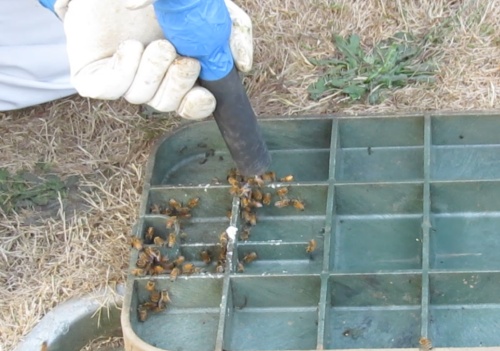
To the left is the cover which is sporting a spiffy observation window. The screened inside box is lined up with the intake tube. Confidence is high.

Shop vac hooked up and plugged in, bee vac ready to go. Note the the size of the hose at 2 1/4″ or 5.7 cm. The bigger diameter means the bees won’t be tumbled as much.

We didn’t know how big the swarm was. Tim from the City Water Dept. had called to say there was a swarm of bees he had to get rid of. Jeff is taking precautions in approaching the area.

After some preliminary issues, the bee vac performed admirably, gently removing bees from the underside of the meter box lid.

Getting the bees removed from behind the below-ground water meter box would have been very difficult without the use of Bob’s Bee Vac. You can see more in the video.

How did the bees come through the hose? Apparently very well.
Not a big swarm, but big enough to get a start on Jeff’s farm.

The transfer to Jeff’s hive took place the following day. The screened inner box is lifted out to be placed over Jeff’s open hive. On a quick inspection, no dead bees were found on the bottom of the box.

Grass blocks the entrance for a couple of days to discourage absconding. Note: This hive is still flying in late February 2016.




It seems an ideal way to get at swarms in awkward places. I wish we had had one when a swarm nested in our chimney. The bee keeper broke some of our tiles catching it and we had a leak during the next rain. It is in fact an ingenious adaptation of a “pooter” which you can use to suck insects into a jar. Amelia
Bob wanted to make sure people knew he didn’t invent this bee vac. He adapted it from looking at various designs on the internet. I’m happy he built it because no one else on the coast (my area) had one. He will be the “go to guy.”
Chimney swarms notch up the difficulty level and you’re right…a bee vac would definitely come in handy. Reading your posts about bees, seeing your interest in bees, photographs and identifications…I’m wondering if you’re getting closer to actually keeping bees. I think you might bee. 🙂
I asked my friend Michel if he would be my mentor and help me set up for next spring. I only decided to take the plunge yesterday as I had been worried about the competition between wild and domesticated bees. I think the countryside around me can support one hive in my garden. My husband is allergic to wasp and I think bee stings so I will not be able to ask him for help.
Neat invention. So is the suction quite gentle on the bees?
I had to do a double take when I was prompted to Approve the comment. Then I realized your last name was changed. Congratulations. I enjoyed the wedding pictures.
The bee vac has a “bleeder valve.” If the suction is too high, you can open it up a bit to reduce the suction so the bees don’t get injured in the hose. To be flexible, the hose has ridges in it. I’ve seen smaller diameter hoses on commercial bee vacs. This hose is a good size. If you go too big, you won’t get as much suction. That said, Shigeo (bee club vice president) uses a hose that is 4″ (10cm) in diameter.
Bob believes in being very gentle with the bees. He was anxious over how the bees would arrive in the box. We were watching carefully and were relieved when we saw them moving around on arrival in the box.
Thanks! It’s good to hear that so much thought went into making sure the bees were unhurt.
I love the idea of a bee vac – what an ingenious solution to swarm removal. We could’ve used one of these at Oxford Circus this summer!